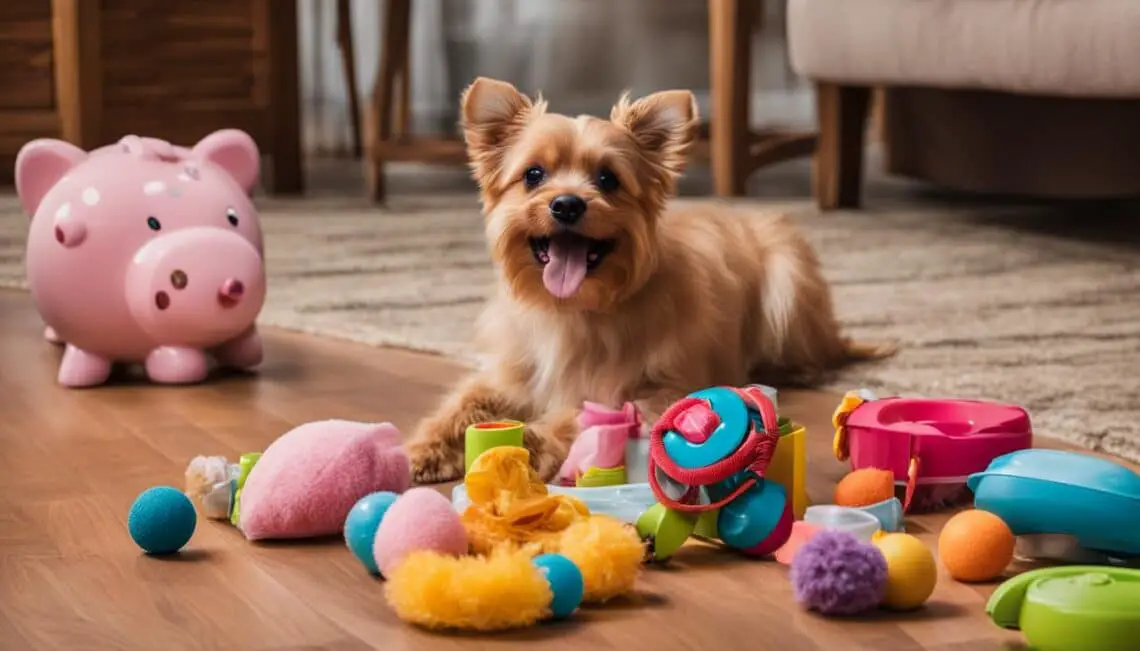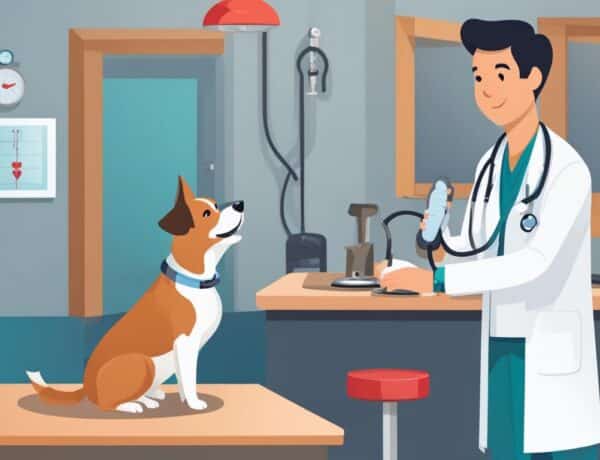As a dog owner, I understand the importance of preparing your small dog for the arrival of a new baby. Introducing a baby to your furry friend requires careful planning and consideration to ensure a smooth transition for everyone involved.
One of the first steps in preparing your small dog for a new baby is getting them accustomed to the changes that will occur in your home. Start by introducing baby gear, such as swings, cribs, and car seats, ahead of time. This allows your dog to familiarize themselves with these new objects and adjust to their presence.
Moving furniture that will be part of the rearranging-for-baby plan now can also help reduce your dog’s stress levels. By making gradual changes to their environment, you can avoid overwhelming them with sudden transformations.
It’s also crucial to gradually change your dog’s routines to prepare them for variations in schedule once the baby arrives. This will help them adapt and prevent any feelings of displacement or competition for attention.
In addition to physical preparations, it’s essential to help your small dog associate new sounds, such as a crying baby, with positive experiences. Offer treats or rewards when these sounds occur, so your dog begins to form positive associations.
Teaching your dog new rules, like sleeping in a different location or being off the furniture, can also help them adjust to the changes that come with a new baby. By establishing these boundaries early on, you can prevent any potential conflicts or jealousy.
Planning ahead for ways to keep your dog entertained and provide them with attention is crucial. Consider asking friends or family members to help walk your dog or play with them. Providing treats, toys, and chew items for independent play can also keep them occupied when your attention is focused on the baby.
Lastly, it’s important to teach your dog important skills for a safe and harmonious interaction with the new baby. Commands such as “go to their place” and “four on the floor” can help establish boundaries and ensure a positive relationship between your small dog and the baby.
Key Takeaways:
- Start preparing your small dog for a new baby as early as possible, gradually introducing them to baby gear and changes in the home.
- Help your dog associate new sounds, like a crying baby, with positive experiences through treats and rewards.
- Teach your dog new rules and boundaries before the baby arrives, such as sleeping in a different location or being off the furniture.
- Plan ahead for ways to keep your dog entertained and give them attention, such as asking for help from friends or family members or providing independent play options.
- Teach your dog important skills, such as “go to their place” and “four on the floor,” for a safe and harmonious interaction with the new baby.
Teaching Your Dog Important New Skills
Prioritize teaching your dog important new skills before the baby arrives. By focusing on basic obedience commands, you can effectively manage your dog’s behavior around the baby and ensure their safety. Start with commands like sit, down, stay, wait at doors, settle, leave it, and drop it. These commands provide a foundation for your dog to understand boundaries and respond to your cues.
In addition to basic obedience, there are other valuable skills you can teach your dog to create a safe and harmonious interaction with the baby. Train your dog to greet people politely without jumping up, as this will prevent them from accidentally knocking into the baby. Teaching your dog to relax in a crate is also beneficial, as it gives them a designated safe space where they can retreat when needed.
Another important command is “go away,” which instructs your dog to move away from the baby if they seem uncomfortable. This command allows you to redirect your dog’s attention and prevent any potential conflict or stress. Additionally, consider teaching your dog hand targeting, where they learn to touch their nose to your hand. This skill can help your dog feel more comfortable and build positive associations with interactions near the baby.
Finally, incorporating playtime into the routine is essential for your dog’s well-being and relationship with the baby. Teach your dog to play fetch with a toy, providing them with a safe outlet for their energy and a fun way to engage with the baby. Regular play sessions not only keep your dog entertained but also promote bonding and positive associations with the new family member.
| Commands | Description |
|---|---|
| Sit | Teaches your dog to sit on command, promoting calm behavior around the baby. |
| Down | Teaches your dog to lie down on command, allowing them to settle in a controlled manner. |
| Stay | Teaches your dog to stay in one place until released, preventing them from approaching the baby without permission. |
| Wait at doors | Teaches your dog to wait politely at doors, creating a safe environment for the baby to enter and exit. |
| Settle | Teaches your dog to relax and stay calm in a designated area, providing them with a space to retreat when needed. |
| Leave it | Teaches your dog to leave objects or items alone, preventing them from grabbing or chewing things that could be harmful to the baby. |
| Drop it | Teaches your dog to release items from their mouth, ensuring they don’t hold onto anything that could pose a risk to the baby. |
Preparing Your Dog for Lifestyle Changes
As I mentioned earlier, preparing your dog for the arrival of a new baby involves more than just introducing them to baby gear and teaching new skills. It’s important to also consider the lifestyle changes that will occur once the baby is here. By gradually transitioning your dog to the new schedule and implementing changes beforehand, you can help them adjust more easily.
One way to manage the additional responsibilities that come with a baby is to hire a dog walker or consider doggie daycare for exercise and socialization. This will ensure that your dog still gets the attention and physical activity they need, even when you’re focused on the baby.
In addition, it’s important to establish new rules and boundaries for your dog before the baby arrives. This could include keeping them off the furniture or out of the baby’s room. By setting these boundaries early on, your dog will have a clearer understanding of their place in the family and will be less likely to feel displaced or confused.
Another aspect of preparing your dog for lifestyle changes is attention management. Gradually reduce the amount of attention your dog receives throughout the day, rather than only giving them attention when the baby is not present. This will help prevent feelings of jealousy or competition and ensure that your dog understands they are still loved and valued.
In summary,
Preparing your dog for lifestyle changes involves gradually transitioning to the new schedule, considering additional help for exercise and socialization, establishing new rules and boundaries, and managing attention effectively. By taking proactive steps to prepare your dog for these changes, you can ensure a smoother transition for both your furry friend and your new bundle of joy.
FAQ
When should I start preparing my small dog for the arrival of a new baby?
Start preparing your small dog as early as possible to allow them time to adjust to the changes.
How can I get my dog used to new equipment and the new set-up of the house?
Introduce baby gear, such as swings, cribs, and car seats, ahead of time, so your dog can become accustomed to them. Move furniture that will be part of the rearranging-for-baby plan now to avoid overwhelming your dog with changes all at once.
What routines should I change gradually to prepare my dog for variations in schedule once the baby comes?
Change routines gradually to help your dog adjust to variations in schedule.
How can I teach my dog to associate new sounds, like a crying baby, with positive experiences?
You can offer treats or rewards when the sound occurs to help your dog associate the new sounds with positive experiences.
Should I teach my dog any new rules before the baby arrives?
Yes, it’s important to teach your dog new rules, such as sleeping in a different location or being off the furniture, to avoid any feelings of displacement or competition with the new baby.
How can I keep my dog entertained and give them attention once the baby arrives?
You can ask friends or family members to walk your dog or play with them, provide treats, toys, and chew items for independent play, or consider doggie daycare or visits to friends or family members for socialization.
What skills should I prioritize teaching my dog before the baby arrives?
Focus on basic obedience commands such as sit, down, stay, wait at doors, settle, leave it, and drop it. Additionally, train your dog to greet people politely without jumping up, relax in a crate, and come when called.
How can I prepare my dog for the lifestyle changes that come with a new baby?
You can gradually transition your dog to the new schedule, hire a dog walker for exercise, establish new rules, teach your dog to settle on their own bed, and work on reducing excessive barking to create a calm environment for the baby.




No Comments